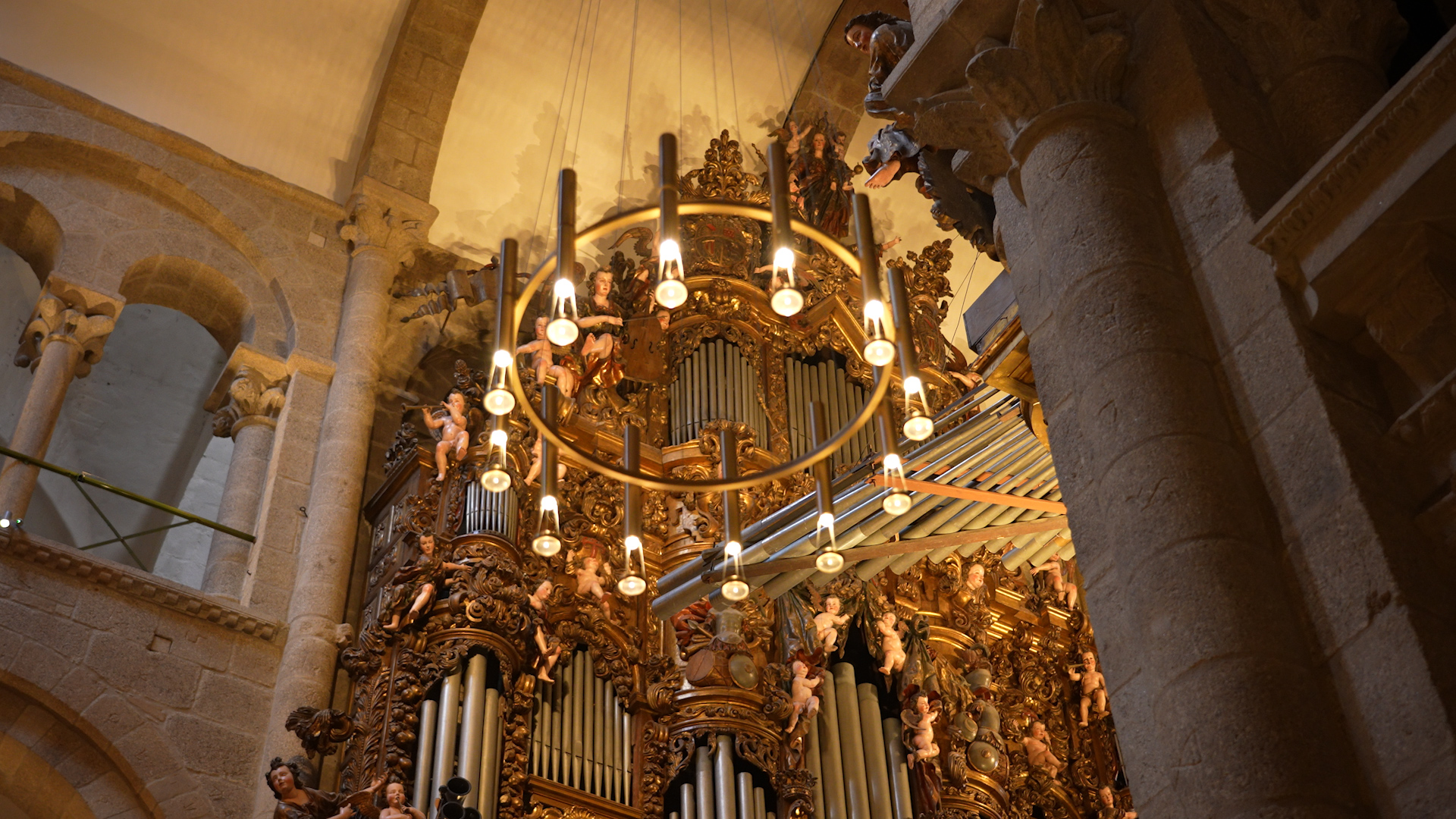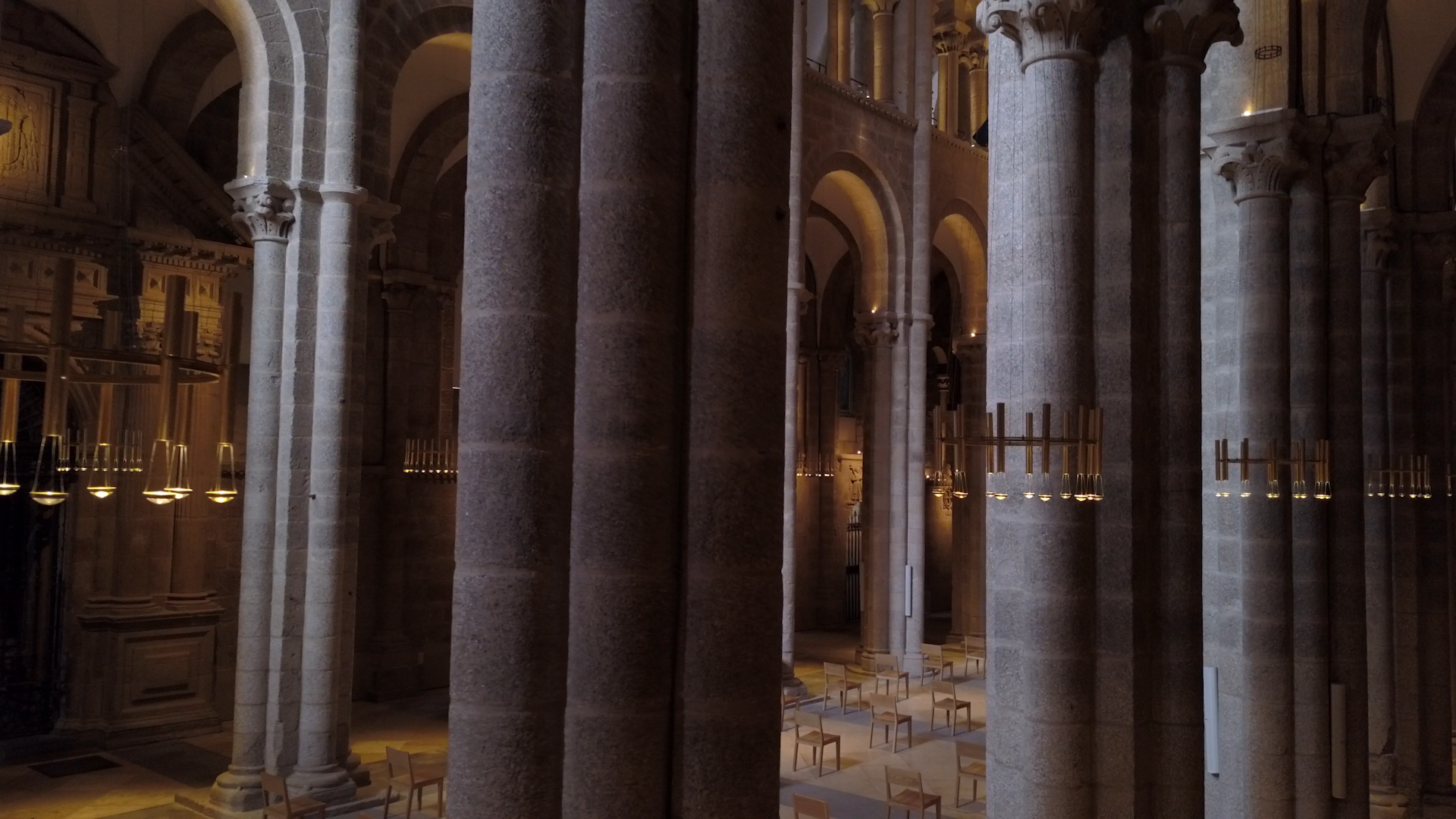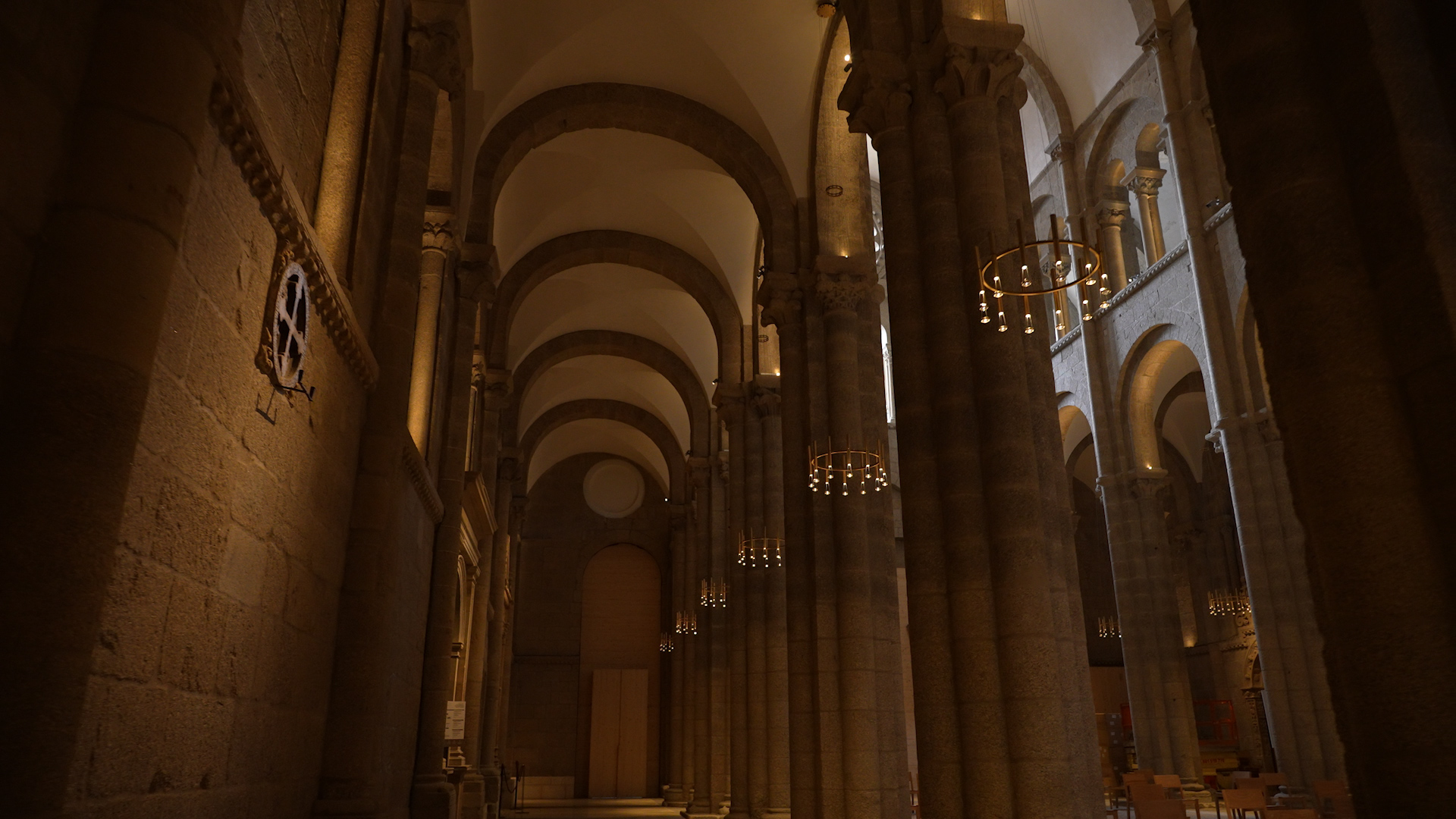- These lamps are designed and manufactured exclusively for the central nave and transepts.
- The lamps are powered from their own cables that keep them suspended from the ceiling.
- Inspired by votive lamps, they seem to “float” inside the Cathedral.
- They recover the historical light plane corresponding to the time when the Temple was illuminated by candles.
- These lamps incorporate the latest lighting technology with 12 LED emitters each.
The lighting works continue after finishing this part of the project following the specifications of the Cathedral’s Master Plan. The aim is to renew the interior lighting of the monument, highlighting the distinctive elements of the naves, transept, ambulatory, triforium and Portico de la Gloria. For the development of this initiative, the Iberdrola Spain Foundation will contribute 800,000 euros.
The project was born after several years of previous studies and reflections by experts and is developed in coordination with all the restoration works being carried out in the Cathedral, in order to ensure their compatibility. In this sense, the natural light of the basilica during the day has been evaluated and, based on this reality, progress has been made in the construction of a criterion for the light in the night scene. This means that the artificial light will not try to compensate or replace natural light, but will be understood as a different visual layer, with levels typical of night light, at warm color temperatures, avoiding the classic lighting of vaults.
The suspended lamps that have just been installed in the Cathedral are inspired by the old votive lamps in the Cathedral, although in this case the lighting is directed towards the floor. Located in the central nave and the transepts, they incorporate the latest technology in lighting with 12 LED emitters each, which in addition to offering a different lighting provides them with great energy efficiency. This light will be the protagonist of the space, as these lamps have been designed exclusively for the Cathedral.
The project was born after several years of previous studies and reflections by experts and is developed in coordination with all the restoration work being carried out in the Cathedral, so as to ensure their compatibility. In this sense, the natural light of the basilica during the day has been evaluated and, based on this reality, progress has been made in the construction of a criterion for the light in the night scene. This means that the artificial light will not try to compensate or replace natural light, but will be understood as a different visual layer, with levels proper to night light, at warm color temperatures, avoiding the classic lighting of vaults.
In addition, from the point of view of use, we will work to make compatible a use of light that, on the one hand, allows to describe the architecture of the monument and, on the other hand, to create an atmosphere of meditation in accordance with the meaning of the temple. Thus, the project sets the guidelines for the implementation of an advanced control system that will make it possible to create different scenes and regulate the lighting levels individually in each of the points, according to the times of visit without worship, ordinary worship and solemn worship.
In short, it is a question of arranging a narrative according to a criterion that is compatible with the history and reality of the Cathedral itself. This “light of the Cathedral” has always been expressed on two very different planes: traditionally, artificial light colonized a plane more or less close to the ground, for reasons of available technology and maintenance, always with warm color temperatures and low levels, and deployed through multiple solutions (candle lanterns for offerings, candlesticks on the consecration crosses, votive lamps, such as those of the angels of the ambulatory that the project proposes to recover).
For its part, natural light is the main protagonist of the higher sections, an abundant light and cold color temperatures, which enhances with its presence the technical and symbolic effort involved in the amazing elevation of the medieval naves, and that, during the night, it is its absence that associates the vast expanse of space in the upper part to the mystery, to the unfathomable. This interesting duality is a narrative on which the project is also based, providing a very significant visual experience for visitors and the faithful.
Iberdrola, with the Santiago Cathedral
Iberdrola has been collaborating with the Cathedral of Santiago since 2004, promoting actions such as the lighting of the Holy Door. Likewise, in 2015 it supported the total renovation of the lighting, as well as the control and electrical installations of the Main Chapel and the Sepulchre of the Apostle. This new project at the Cathedral of Santiago de Compostela reinforces Iberdrola’s commitment to Galicia and its ongoing commitment to promoting the social value of culture and the protection and conservation of the region’s historical-artistic heritage.
“The initiative represents the key objectives of our actions in this area: the conservation of the monument and its transcendence in the community and to local development and the contribution to the conservation of its elements, putting in value and enhancing the unique features of the architecture and prioritizing sustainability and energy efficiency,” explains Fernando García president of the Iberdrola Foundation.
The Cathedral of Santiago
Around the year 820-830 the Inventio would take place, the discovery of the tomb of Santiago and his disciples by Bishop Teodomiro of Iria Flavia. It was the beginning, then, of a phenomenon through which, with significant support from the monarchy, was configured in the northwest of the Iberian Peninsula one of the main references of Christianity that, one thousand two hundred years later, continues to attract thousands of faithful and pilgrims through the Camino de Santiago, declared by Unesco First European Cultural Itinerary.
To guard and venerate the apostolic tomb, which took advantage of a pre-existing Roman mausoleum, Alfonso II promoted the construction of a first temple that, due to the rapid increase in pilgrimages, soon became too small and had to be replaced by a pre-Romanesque basilica built in the time of Alfonso III, the Great and consecrated in 899. This temple was razed by the army of the Muslim leader Almanzor in 997 and quickly rebuilt, incorporating new architectural elements, in the early years of the eleventh century, thus avoiding the interruption of the cult of the Apostle and the pilgrimages to his tomb.
The Basilica of Alfonso III was becoming too small in the face of the important increase in pilgrimages to Compostela. Therefore, around the year 1075, in the time of King Alfonso VI of León and Bishop Diego Peláez, the construction of the Cathedral began on the eastern side, which had to go through several phases until its consecration, with a solemn ceremony presided over by Archbishop Pedro Muñiz and King Alfonso IX of León, on April 21, 1211.
In the more than eight hundred years since its consecration, the cathedral has not stood still and its appearance, exterior and interior, has varied greatly, incorporating all artistic styles. Liturgical and functional issues have added to the original structure, with new constructions and decorative elements. All this has enriched the cultural heritage of the cathedral, both in terms of its construction and the artistic collections that make it up, in which the offerings, bequests and commissions from prelates, capitulars, kings, dignitaries and pilgrims who, over twelve hundred years of history have left their mark on a temple that is the heart and raison d’être of Compostela and Galicia, also have a special importance.
Neither has worship in the cathedral stopped, nor the flood of pilgrims who, in a renewed boom of pilgrimages to Santiago has become, in recent decades in a real mass phenomenon. In 2019, more than 300,000 pilgrims will have reached Compostela meeting the standards set by the Church to certify the Camino; to them must be added the millions of faithful and visitors who visited the cathedral, making it one of the most visited monuments in Spain and presaging an upcoming Holy Year 2021 that will undoubtedly exceed all expectations of attendance and participation.
Iberdrola with cultural and artistic wealth in Spain
Iberdrola, through its foundation in Spain, dedicates a significant part of its work to projects for the care, conservation and enhancement of cultural and artistic wealth in Spain. Since 2011, the volume of investment in this type of initiatives has amounted to 12.6 million euros and has been directed to two main lines of work: the Restorations Program, for the conservation of its pictorial and artistic heritage; and the Illuminations Program, which contemplates the design, execution and financing of artistic lighting projects in unique buildings and monuments.
This last program has developed more than 40 lighting projects in monuments or singular buildings, including the historic Roman Bridge of Alcántara (Cáceres), the façade of the Congress of Deputies, the exterior of the Supreme Court, the church of the Monastery of El Paular (Madrid), the illuminations of the Monastery of Guadalupe, the Royal Pantheon of the Collegiate Church of San Isidoro (León), the new exterior lighting of the Cathedral of Ávila, or the interior of the Cathedral of Palencia, among others.
Another unique initiative is the Iluminando el Prado/Lighting the Prado program, a comprehensive lighting project for the Prado Museum using LED technology that is a pioneer and a benchmark in Europe.



